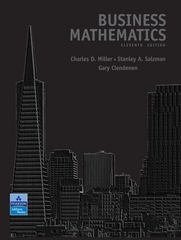Question
Q1. You need to raise $1M in cash to finance a one-year investment opportunity. The investment opportunity pays $1.5M in cash next year if economic
Q1. You need to raise $1M in cash to finance a one-year investment opportunity. The investment opportunity pays $1.5M in cash next year if economic conditions are good (50% probability). Otherwise, the investment opportunity pays $900K in cash if economic conditions are bad (50% probability). Assume a risk-free rate of 5% and no taxes.
a) Suppose that you raise $1M in cash by issuing $800K in equity and $200K in debt. Equity holders are the residual claimants on the final cash flows from the investment after the debtholders are repaid their principal and interest. The expected return on debt equals the risk-free rate because the proceeds from the project can repay the debt plus interest, regardless of the state of the economy. What is the expected return on equity? What is the expected return on assets? (Use the weighted average cost of capital equation to answer the latter question.)
b) Answer the questions in part (a) again, but instead assume that you raise $1M in cash by issuing $500K in equity and $500K in debt. The expected return on debt will still equal the risk-free rate.
c) Answer the questions in part (a) again, but instead assume that you raise $1M in cash by issuing $200K in equity and $800K in debt. The expected return on debt will still equal the risk-free rate.
d) Answer the questions in part (a) again, but instead assume that you raise $1M in cash by issuing $50K in equity and $950K in debt. Because the debtholders will only be repaid $900K in the bad state, they will ask for a promised return of 35.79% in the good state. What is the expected return on debt? What is the expected return on equity? What is the expected return on assets?
the main idea is to first calculate the expected cash flow to assets, debt, and equity. Then, calculate the expected returns to assets, debt, and equity. Step by step,
Step 1, what are the expected cash flows E(CF).
a. For assets, E(CFa): (ProbGoodState)*(AssetValueGoodState)+(ProbBadState)*(AssetValueBadState) = x.
b. For debt, E(CFd):(ProbGoodState)*(D)*(1+r)+(ProbBadState)*(D)(1+r) = y, note that the debt holders are repaid the debt plus interest, so their expected cash flow will include the principal (D) plus the interest on the debt (r*D).
c. E(CFe): (ProbGoodState)*(AssetValueGoodState - D(1+r))+(ProbBadState)*(AssetValueBadState - D(1+r))= z, note that we are taking the asset cash flow less the debt and interest for the good state and the bad state.
Step 2, What is the expected return to assets E(Ra), debt E(Rd), and then equity E(Re)? a. E(Rd): it will be the risk free rate because it can be repaid no matter what happens, so that rate is given. b. E(Re): E(CFe)/E = [z]/(E) : that is, the expected return on the equity will be the expected cash flow to equity holders divided by the initial equity (Equity) that you have used to fund the project.c. E(Ra): (D/D+E)Rd + (E/D+E)Re, note that the weights on your WACC, the debt and equity ratios, D/D+E, E/D+E are from how the project was financed
Step by Step Solution
There are 3 Steps involved in it
Step: 1

Get Instant Access to Expert-Tailored Solutions
See step-by-step solutions with expert insights and AI powered tools for academic success
Step: 2

Step: 3

Ace Your Homework with AI
Get the answers you need in no time with our AI-driven, step-by-step assistance
Get Started


